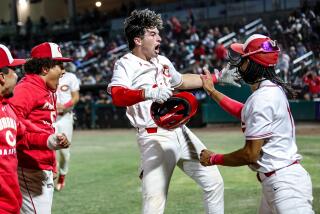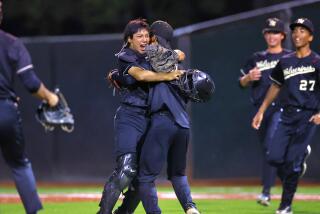Wooden Bats Stump Young Players : Minor leagues: Making adjustment from aluminum has batters scratching their heads, and pitchers smiling.
ANAHEIM — Erren O’Leary knocked the ball all over the field this summer for the California Seals--batting .427 with 11 doubles and one triple. But when it came to knocking it over the fence, O’Leary always came up a little short.
“I don’t know what it was, the ball or what, but I couldn’t get it out of the park,” said O’Leary, former Sunny Hills High player and now starting catcher for San Diego State. “I hit some balls that felt great. I think we were using bad balls this summer.”
It’s not the ball, Erren, it’s the bat.
The wooden bat.
After playing baseball only with aluminum bats, O’Leary and many collegians playing in the Southern California Collegiate League suddenly are experiencing the frustration of being sawed off and watching helplessly as pieces of their bat fly farther than the ball.
But for Jeff Kight, a left-handed pitcher with the Seals, the experience has been thoroughly enjoyable.
“If you get the ball inside, and they make contact, a lot of times you can just hear the bat shatter in their hands,” said Kight, a senior at Cal State Sacramento who played at Sunny Hills. “You get a little smile on your face, and it gives you a feeling of satisfaction.”
Paul (Pops) Ivanovsky, coach and general manager of the Anaheim-based Seals, is satisfied that Southern California collegians have a wood-bat summer league to call their own. Until three years ago, Southern Californians traveled to Alaska or Cape Cod, Mass., to swing some wood.
Ivanovsky, who ran ex-Dodger Manny Mota’s baseball camp for five years, is one of the Southern California Collegiate League’s founders. Former Dodger and Angel pitcher Bill Singer also was involved in the formation of the league, which receives funds from Major League Baseball through the NCAA.
“Cape Cod is a place every kid should go, but we feel we have just as much to offer, and we have much nicer fields and better weather,” Ivanovsky said.
This weekend, the SCCL is having a season-ending international wooden-bat tournament at Brookhurst Park in Anaheim. Teams from Canada and Phoenix will be competing in the five-team round robin-tournament, which also includes the Orange County Cardinals and the SCCL’s Seals and Irvine Tigers.
The San Bernardino Indians, which finished with a SCCL-best 20-6 record, are in Wichita this weekend for the National Baseball Congress World Series.
Ivanovsky said the SCCL is prospering and expanding. Next year, the league will grow from six to eight teams. Although the league’s focus is indoctrinating college players to wooden bats, Ivanovsky said the SCCL has other advantages.
“The players will learn something here, while they’re getting a chance to stay home for summer and eat home cooking,” he said. “This league also helps the kids graduate. They can stay home and go to summer school, work, and it’s a pleasure for their parents to have their kids home again.”
Ivanovsky said the league is also attractive to Southern California college coaches.
“If I’m (USC baseball Coach) Mike Gillespie, it’s more attractive to have my kid where I can see him,” he said.
But more than anything, the SCCL is training ground for professional baseball, which does not allow the use of aluminum bats.
“This is the first time I’ve ever used a wood bat,” O’Leary said. “Hopefully, I’d like to go on to play pro ball. There’s really a difference in the two, and a lot of adjustments have to be made.”
Seal outfielder Ken Overby, a teammate of O’Leary’s at Sunny Hills and San Diego State, said he wondered if he would ever adjust to swinging wood.
“I took a swing in high school practice once and barely hit the ball out of the infield,” Overby said. “I really struggled here at first too.”
But not everyone had a rough adjustment period.
“The first couple of games, I could throw it over the plate and let them hit it,” said Kight, who had a 2-2 record with a 2.57 earned-run average for the Seals this season. “Their bats were heavier than they were used to, and no one really knew what they were doing. Their bat speed just isn’t there.”
Ivanovsky realizes that nearly every batter struggles initially, so he came up with some tips to help ease the transition.
“We cut their bat (length) down an inch, and we give them a heavier bat and a thicker handle--thin handles break too easily,” Ivanovsky said. “Then we advise them to use a split-hand grip, which cuts the arc of the swing down and forces them to use their hands instead of their arms.”
Ivanovsky also has some advice for hitters with slow hands.
“The kids with slower hands are gripping the bat too tight,” he said. “So we tell them to release the index finger on the top hand and have them bend their thumb downward. Those two things can pick up 25 m.p.h. on bat speed.”
O’Leary said the key has been bat preparation.
“Getting the bat head out quickly helped me more than anything,” he said. “The sweet spot is smaller with wood, so you have to make sure you get your bat ready.”
After the season’s first few weeks, Kight said things started to even out.
“Their bat speed picked up, and their timing improved,” Kight said.
Still, Kight said he’d rather throw to batters with wood in their hand.
“With aluminum, sometimes I’d make a good pitch in on the handle,” he said. “And before you knew it, it was out of the yard. With wood, if you make a good pitch, you’re usually rewarded.”
But Overby said he’s eager to pick up the aluminum again this fall.
“When you go back to aluminum, it feels like you’re swinging a golf club,” said Overby, who hit about .280 this summer. “Your bat speed is a lot different. Sometimes you even have to slow yourself down.”
More to Read
Go beyond the scoreboard
Get the latest on L.A.'s teams in the daily Sports Report newsletter.
You may occasionally receive promotional content from the Los Angeles Times.










